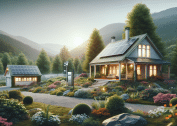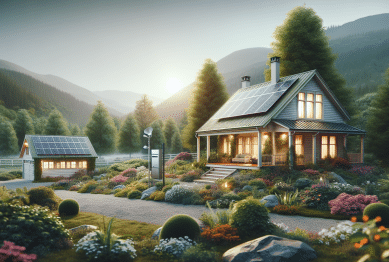If you’ve been dreaming of an attractive outdoor space that doesn’t demand constant attention, explore what makes low-maintenance gardens so appealing. Discover design tips, plant choices, and clever landscaping ideas for a modern yard that flourishes with minimal effort.
Why Low-Maintenance Gardens Appeal to So Many
For many homeowners, a low-maintenance modern garden is the ideal solution. It offers all the aesthetic perks of a lush outdoor space without the stress and effort of continual upkeep. With today’s fast-paced routines, people increasingly seek garden designs that fit their busy lives. Instead of spending hours mowing, pruning, or weeding, a thoughtfully planned garden can look great with just a bit of attention here and there. Embracing this style doesn’t mean settling for bland or boring. Rather, it’s about intentional choices that create harmony between plants, materials, and lifestyle preferences.
Modern garden design trends focus on smart layouts and resource-conscious materials. This isn’t just about convenience. Many eco-minded homeowners also appreciate that low-maintenance gardens often use fewer chemical fertilizers, less water, and promote local biodiversity. Less frequent mowing means less noise and air pollution, too. By combining native planting with strategic use of mulch or stone, busy families and professionals alike can maximize their time enjoying the outdoors, rather than feeling burdened by it.
There’s also a wellness angle: stress relief and calm are easier to find in a manageable, uncluttered space. An outdoor area that is beautiful but not overwhelming makes it possible to truly unwind after a long day. Elements like evergreen shrubs, ornamental grasses, or gravel pathways exist to be enjoyed, not constantly tended. This thoughtful approach to gardening showcases the shift from striving for perfection towards designing for lived-in beauty. Less time working outside means more time spent connecting with nature, friends, or simply a good book on the patio.
Key Elements of a Modern Low-Maintenance Garden
Modern garden design highlights clean lines, geometric shapes, and streamlined materials. Pathways created with paving stones, concrete, or decorative gravel are popular for their tidy appearance and practicality. Raised beds built from timber or steel require less bending and deter weeds, making them a favorite for urban gardeners. Furniture and planters in neutral tones and natural materials visually anchor the space and allow greenery to stand out.
Incorporating hardscaping is essential in minimizing ongoing work. Decks, patios, and gravel areas reduce the size of the lawn, meaning less mowing and less opportunity for weeds to invade. Perennial borders edged with stone or metal keep soil neatly in place while preventing grass from crossing into flowerbeds. Lighting can add dramatic effect and security, and choosing LED solutions means you won’t need to replace bulbs frequently. Including automatic irrigation can help maintain plant health with very little human intervention.
Water features, such as simple fountains or birdbaths, evoke a sense of tranquility without adding extra chores. Consider using drought-resistant lawns, bark chips, or ground covers in areas that may otherwise become muddy or weedy. Selecting the right paving – and even choosing artificial grass for shaded or high-traffic corners – may further reduce time spent on upkeep. All these elements combine for a space that’s as enjoyable to look at as it is to use, without those endless gardening chores.
Best Plants for Effortless Year-Round Appeal
Choosing the right plants is crucial. Native varieties are often the top choice for low-maintenance landscapes since they adapt well to local soils, climate, and pests. Grasses like blue fescue, feather reed grass, and miscanthus add movement and structure while requiring very little trimming or dividing. Succulents – think sedum, hens and chicks, or agave – create bold shapes and need only occasional watering. Evergreen shrubs, including boxwood or juniper, offer structure and greenery even during colder months.
Perennials provide lasting pops of color and rarely need replanting. Lavender, Russian sage, and coneflowers thrive with minimal watering. Mulching around their base retains moisture and stifles weed growth. When designing a garden, it’s wise to layer different heights, from ground covers to flowering shrubs to taller grasses, giving the garden visual interest without requiring re-planting each season. Ornamental trees like Japanese maple or dogwood can deliver spring blooms and stunning foliage with little intervention.
Ground covers such as creeping thyme, woolly yarrow, and vinca can swiftly fill bare soil, keeping weeds at bay and reducing the need for constant mulching or watering. In shaded spots, hostas and ferns add texture and lushness with very little fuss. Many modern gardens also incorporate low-care bulbs, such as daffodils and crocus, which return year after year. The beauty of low-maintenance plantings is in their resilience and their ability to delight homeowners with very little assistance.
Smart Watering and Soil Practices for Modern Gardens
Efficient watering systems are at the heart of a foolproof low-maintenance garden. Drip irrigation delivers water right to the base of each plant, reducing waste while minimizing disease risk. Smart controllers can adjust watering frequency based on weather conditions, which is both sustainable and cost-effective. Collecting rainwater in barrels is an eco-friendly method that supports garden health through dry spells.
Soil health is another pillar of successful modern gardens. Amending new beds with compost, decomposed bark, or aged manure creates a structure that holds moisture and nutrients longer, so plants thrive with less input. Mulching not only locks in water but keeps weeds at bay and maintains consistent soil temperatures. For those planting in containers or raised beds, using high-quality potting mixes rich in organic matter supports growth without frequent fertilizing.
Practices like xeriscaping – designing with water conservation in mind – are gaining traction, especially in areas prone to drought. By grouping plants with similar moisture needs, irrigation can be concentrated where it’s needed most. This approach, alongside periodic soil testing and choosing deep-rooted species, ensures healthy gardens that resist pests, disease, and climate swings. Overall, prioritizing water efficiency and robust soils means gardens remain vibrant without continual intervention.
Easy-Care Features That Maximize Outdoor Enjoyment
To truly make the most of your garden, focus on outdoor living spaces designed for comfort and utility. Weather-resistant furniture, built-in seating, and shade elements like pergolas or simple umbrellas create zones for dining, relaxing, or entertaining friends. Choosing items that are easy to wipe clean or resistant to mildew keeps chores to a minimum while maintaining a polished look.
Storage solutions also contribute to a clutter-free, low-maintenance space. Garden benches with hidden compartments, vertical wall hangers, or compact sheds help keep outdoor tools, cushions, and play equipment tidy and protected from the elements. By planning for year-round outdoor use – with fire pits, outdoor heaters, or string lights – homeowners can extend enjoyment of their space even as seasons change, without needing major seasonal overhauls.
Wildlife-friendly touches, such as pollinator gardens or bird boxes, can increase biodiversity with little direct upkeep. Even a small meadow patch reduces mowing and supports bees, butterflies, and birds. Blending ornamental grasses with perennials or installing a gravel seating nook turns any yard into a tranquil escape. It’s through thoughtful, low-effort features that a garden becomes a welcoming haven rather than a demanding chore list.
Budgeting and Maintenance: Setting Realistic Expectations
While low-maintenance gardens minimize labor over time, they may involve some up-front investment. Quality hardscaping materials, irrigation systems, and mature plant stock can be more expensive initially, but they result in gardens that need less ongoing care. Many find the long-term savings in time, water, and chemicals to be well worth it. By starting with a clear vision, homeowners can set priorities that align with budget and lifestyle goals.
It’s helpful to schedule routine seasonal tasks, such as trimming shrubs, topping up mulch, or checking irrigation lines. Hiring a garden consultant for the initial design or periodic upkeep can ensure things stay on track. There are resources for learning what tasks are most crucial, so you won’t get caught off-guard by surprises like overgrown borders or unreliable plants. In many cases, low-maintenance doesn’t mean no-maintenance—it’s about making the most of intentional, manageable care.
Online forums, university extension offices, and gardening clubs are a wealth of advice for troubleshooting and inspiration. These networks let you confirm which plant choices or materials work best in a particular climate or soil type. As the seasons unfold, reviewing successes and learning from challenges helps refine a garden, making it even easier to enjoy in years to come. The most successful low-maintenance gardens grow and adapt along with their owners’ needs and preferences.
References
1. Royal Horticultural Society. (n.d.). Low Maintenance Gardens. Retrieved from https://www.rhs.org.uk/garden-inspiration/garden-types/low-maintenance
2. The National Wildlife Federation. (n.d.). Garden For Wildlife: Low Maintenance Gardens. Retrieved from https://www.nwf.org/Home/Garden-for-Wildlife/Gardening-Tips/Low-Maintenance
3. University of California Master Gardener Program. (n.d.). Drought Resistant Landscaping. Retrieved from https://mg.ucanr.edu/planting-drought-resistant-landscapes/
4. United States Environmental Protection Agency. (n.d.). Water-Smart Landscapes. Retrieved from https://www.epa.gov/watersense/water-smart-landscapes
5. American Society of Landscape Architects. (n.d.). Sustainable Residential Design. Retrieved from https://www.asla.org/sustainable-residential-design.aspx
6. BBC Gardeners’ World Magazine. (n.d.). Easy-Care Plants for Low Maintenance Gardens. Retrieved from https://www.gardenersworld.com/plants/easy-care-plants-for-a-low-maintenance-garden/









